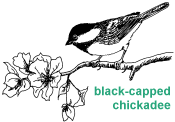 Bird watching is among the most popular of all American recreational pursuits. Of the world's more than 9,000 species of birds, over 200 are known to breed in Michigan and more than 400 species spend at least some time in the state. The list includes many songbirds ranging from the common American robin to the endangered Kirtland's warbler.
Bird watching is among the most popular of all American recreational pursuits. Of the world's more than 9,000 species of birds, over 200 are known to breed in Michigan and more than 400 species spend at least some time in the state. The list includes many songbirds ranging from the common American robin to the endangered Kirtland's warbler. Songbirds use many different types of habitat including forests, grasslands, wetlands, and shrublands. Michigan's landscape has changed greatly since the early 1800's when the first European settlers arrived. No longer are there vast forests in southern Michigan, and we have lost over 35% of wetlands statewide. Land development continues to fragment the state.
Many songbirds are sensitive to size and shape of their habitat. "Area sensitive" species including some warblers, flycatchers, thrushes, and ovenbirds have low tolerance to fragmented habitat. For this reason area sensitive species tend to seek out grasslands, forests, or wetlands hundreds of acres in size.
Many of these species are declining in number as they no longer have these large unfragmented breeding areas. However, other species such as cardinals, chipping sparrows, and chickadees can tolerate fragmentation and may even thrive alongside humans. These species are most often seen in urban areas, and are fairly common.
Conservation
Your landscape determines the opportunities you have for bird conservation. The following describes some of the basic habitat needs of songbirds.
- Territory
Territorial needs vary with each bird species. Eastern bluebirds, for instance, are territorial and need about five acres per pair. You can create a larger area for those species that are territorial by working with neighbors.
- Water
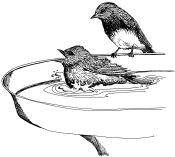 Most songbirds need open water of some kind. Luckily, Michigan is home to wetlands, lakes, rivers, streams, and ponds. However, providing a water source on your property can attract songbirds up close. A small bath with shallow edges draws them to bathe, drink and help control their body temperatures.
Most songbirds need open water of some kind. Luckily, Michigan is home to wetlands, lakes, rivers, streams, and ponds. However, providing a water source on your property can attract songbirds up close. A small bath with shallow edges draws them to bathe, drink and help control their body temperatures. Birds are attracted to the noise of flowing water. Providing moving water may increase songbird usage but is not mandatory. Misters and drippers are other means to move water and draw more birds. Songbirds will use water sources year round. In winter consider providing water in a heated birdbath.
- Food
Natural foods, such as fruits, nuts and seeds provided by trees, shrubs, grasses, and flowers will attract a variety of songbirds. Planting highbush cranberry, dogwoods, or other fruiting shrubs on your property may draw migrants as well as resident birds. These plants can also provide areas to sing, court, nest, rest and hide, as well as pleasing landscapes.
Locating feeding stations in several places reduces crowding and remember to clean the feeders frequently.
- Shelter
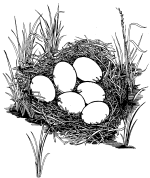 Songbirds use cover for shelter, nesting, and brood rearing. Dependent on the type of species, required cover types could vary from woodlands to grasslands to wetlands. After assessing what cover types are available on your property, you can determine what species you will be able to attract. By planting trees, shrubs, grasses, and adding nest boxes, you can enhance the cover and attract more species.
Songbirds use cover for shelter, nesting, and brood rearing. Dependent on the type of species, required cover types could vary from woodlands to grasslands to wetlands. After assessing what cover types are available on your property, you can determine what species you will be able to attract. By planting trees, shrubs, grasses, and adding nest boxes, you can enhance the cover and attract more species.Backyard Areas
Many kinds of songbirds are attracted to balconies, decks, lawns, and ornamental shrubs and trees in both rural and urban settings. You do not even need to own property to enjoy songbirds as they may visit your condominium or apartment complex. For example the Cardinal, Blue Jay, Black-capped Chickadee, House Sparrow, House Finch, American Goldfinch, European Starling, White-breasted Nuthatch, Downy Woodpecker, and Mourning Dove are among the many species that nest in urban habitats.
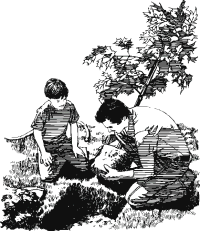 Regardless of where you live, it is helpful to maintain a diverse yard with an abundance of trees and shrubs, as well as areas with leaf cover for ground-feeding birds. Consider planting a variety of native tree and shrub species such as white spruce, hemlock, white pine, oaks, sugar maple, flowering dogwood, and juneberry. Cardinals will nest in dense shrubbery, chipping sparrows in pines and spruces, and house wrens in cavities of trees or nest boxes. Even wood ducks and screech owls will nest in town if tree cavities or nesting boxes are present. In winter, you may find pine siskins feeding on cones of your evergreens.
Regardless of where you live, it is helpful to maintain a diverse yard with an abundance of trees and shrubs, as well as areas with leaf cover for ground-feeding birds. Consider planting a variety of native tree and shrub species such as white spruce, hemlock, white pine, oaks, sugar maple, flowering dogwood, and juneberry. Cardinals will nest in dense shrubbery, chipping sparrows in pines and spruces, and house wrens in cavities of trees or nest boxes. Even wood ducks and screech owls will nest in town if tree cavities or nesting boxes are present. In winter, you may find pine siskins feeding on cones of your evergreens.Other Considerations
Use native plant species for plantings whenever possible. Alien species, such as purple loosestrife, garlic mustard, autumn olive, and glossy buckthorn, should be avoided and actively removed as they displace native species used by birds as food sources and sheltered sites.
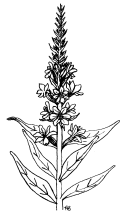 purple loosestrife |  garlic mustard | 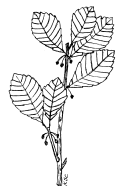 glossy buckthorn |
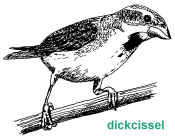 House cats can be a major predator of songbirds and should be kept indoors. If this is not possible, securing bells to their collars when outdoors can help warn birds and small mammals of their presence, thus reducing their impact as a predator.
House cats can be a major predator of songbirds and should be kept indoors. If this is not possible, securing bells to their collars when outdoors can help warn birds and small mammals of their presence, thus reducing their impact as a predator.Feeding songbirds can be educational and fun. To enjoy the full benefit of songbirds, get a good field identification guide that contains color pictures or paintings and buy a quality pair of binoculars. You may even wish to keep a checklist of birds that visit your land in order to determine the variety of birds that you have attracted to your area.
Source: Sargent, M.S and Carter, K.S., ed. 1999. Managing Michigan Wildlife: A Landowners Guide. Michigan United Conservation Clubs, East Lansing, MI. 297pp.
Related Articles:
- The best heated bird baths http://bit.ly/uIHnB7
- How do you become a birdwatcher? http://bit.ly/rquunU
- Best field guide for Michigan birds http://bit.ly/vPOMx1
- What are the Best Binoculars: How to Choose Optics http://bit.ly/vZW26j
- Most common winter birds in Michigan http://bit.ly/vUZynL
Category ›
Bird Basics
 Unknown
Unknown
 Saturday, December 31, 2011
Saturday, December 31, 2011











No comments:
Post a Comment